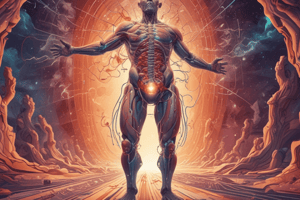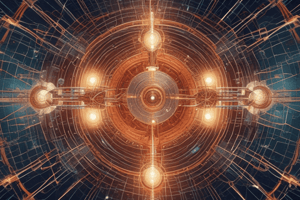Podcast
Questions and Answers
What is a force?
What is a force?
Force is an external agent capable of changing a body's state of rest or motion.
What are two categories of forces we can experience?
What are two categories of forces we can experience?
Forces we are unaware of inside the body, and forces we are aware of on the body.
What are the two types of forces that affect the body?
What are the two types of forces that affect the body?
- Both A and B (correct)
- Forces in the body
- Forces on the body
What are the categories of forces that affect the body?
What are the categories of forces that affect the body?
What is the equation for the force of gravity on earth?
What is the equation for the force of gravity on earth?
What is one of the important medical effects of gravity?
What is one of the important medical effects of gravity?
Gravity has a positive effect on the skeleton.
Gravity has a positive effect on the skeleton.
Briefly define electrical force.
Briefly define electrical force.
What is one impact of electrical forces in the body?
What is one impact of electrical forces in the body?
Electrical eels are able to produce a stunning voltage.
Electrical eels are able to produce a stunning voltage.
What are the two types of nuclear forces?
What are the two types of nuclear forces?
What is the main function of frictional force?
What is the main function of frictional force?
Where do we use frictional forces?
Where do we use frictional forces?
Friction in bone joints is usually much lower than in engineering-type materials.
Friction in bone joints is usually much lower than in engineering-type materials.
What aspect of frictional force is still controversial?
What aspect of frictional force is still controversial?
What diseases are known to increase friction in bone joints?
What diseases are known to increase friction in bone joints?
What is the vertical reaction force supplied by the surface called?
What is the vertical reaction force supplied by the surface called?
What equation is used to calculate the horizontal component of friction?
What equation is used to calculate the horizontal component of friction?
What is static equilibrium?
What is static equilibrium?
What conditions must be met for static equilibrium?
What conditions must be met for static equilibrium?
What are levers?
What are levers?
What are the three types of levers?
What are the three types of levers?
Where is the fulcrum located in a first-class lever?
Where is the fulcrum located in a first-class lever?
What is a common medical example of a first-class lever?
What is a common medical example of a first-class lever?
Where is the resistance located in a second-class lever?
Where is the resistance located in a second-class lever?
What common object is an example of a second-class lever?
What common object is an example of a second-class lever?
Where is the applied force located in a third-class lever?
Where is the applied force located in a third-class lever?
What common medical example is used to illustrate a third-class lever?
What common medical example is used to illustrate a third-class lever?
What tool or device is often used in medicine and is a good example of a lever?
What tool or device is often used in medicine and is a good example of a lever?
What are the two most important muscles involved in the movement of the elbow?
What are the two most important muscles involved in the movement of the elbow?
What does the contraction of the triceps cause?
What does the contraction of the triceps cause?
How does the force exerted by a muscle compare to the weight it holds up?
How does the force exerted by a muscle compare to the weight it holds up?
What does the dynamic force play a key role in?
What does the dynamic force play a key role in?
How does the dynamic force relate to Newton's laws of motion?
How does the dynamic force relate to Newton's laws of motion?
What is the explanation for the dynamic force equation?
What is the explanation for the dynamic force equation?
The human body is a dynamic system that responds to internal and external stimuli.
The human body is a dynamic system that responds to internal and external stimuli.
Flashcards
Gravitational Force
Gravitational Force
The force that attracts objects towards the center of the Earth, moon, or other massive objects. This is also known as the object's weight.
Strong Nuclear Force
Strong Nuclear Force
A fundamental force that binds protons and neutrons together in the nucleus of an atom.
Weak Nuclear Force
Weak Nuclear Force
A very weak force that acts on quarks, the particles that make up protons and neutrons. It is responsible for beta decay.
Frictional Force
Frictional Force
Signup and view all the flashcards
Static Force
Static Force
Signup and view all the flashcards
Dynamic Force
Dynamic Force
Signup and view all the flashcards
First-Class Lever
First-Class Lever
Signup and view all the flashcards
Second-Class Lever
Second-Class Lever
Signup and view all the flashcards
Third-Class Lever
Third-Class Lever
Signup and view all the flashcards
Posture
Posture
Signup and view all the flashcards
Mobility
Mobility
Signup and view all the flashcards
Applied Force
Applied Force
Signup and view all the flashcards
Resistance Force
Resistance Force
Signup and view all the flashcards
Fulcrum
Fulcrum
Signup and view all the flashcards
Mechanical Advantage
Mechanical Advantage
Signup and view all the flashcards
Effort Arm
Effort Arm
Signup and view all the flashcards
Resistance Arm
Resistance Arm
Signup and view all the flashcards
Vein
Vein
Signup and view all the flashcards
Varicose Veins
Varicose Veins
Signup and view all the flashcards
Bone Loss
Bone Loss
Signup and view all the flashcards
Diffusion
Diffusion
Signup and view all the flashcards
Passive Transport
Passive Transport
Signup and view all the flashcards
Active Transport
Active Transport
Signup and view all the flashcards
Synovial Joint
Synovial Joint
Signup and view all the flashcards
Synovial Fluid
Synovial Fluid
Signup and view all the flashcards
Arthritis
Arthritis
Signup and view all the flashcards
Homeostasis
Homeostasis
Signup and view all the flashcards
Muscular Response
Muscular Response
Signup and view all the flashcards
Hormonal Response
Hormonal Response
Signup and view all the flashcards
Metabolism
Metabolism
Signup and view all the flashcards
Digestion
Digestion
Signup and view all the flashcards
Excretion
Excretion
Signup and view all the flashcards
Study Notes
Lecture 5: Force on and in the Body
- Force is an external agent that changes a body's state of rest or motion. It has magnitude and direction.
- The direction of the force is the direction in which it is applied.
- The application point of the force is the point where the force is applied.
How Forces Affect the Body
- Forces inside the body (unaware of): These include muscular forces that circulate blood and cause the lungs to take in air. They also include forces that determine where atoms and molecules stay in the body.
- Forces on the body (aware of): These include the forces involved when we bump into objects.
The Force
- Forces in the body:
- Gravitational force
- Nuclear force
- Electrical force
- Forces on the body:
- Frictional force
- Static force
- Dynamic force
1- Gravitational Force
- Gravity is the force with which Earth, the moon, or other large objects pull on other objects.
- This is how objects are weighed.
- On Earth, the force of gravity (weight) is calculated with the equation F = m * g.
- Where:
- F = force (weight)
- m = mass
- g = acceleration due to gravity (9.8 N/kg or 980 dyn/gm)
- Where:
- Gravity affects varicose veins and bone health (space travel, long-term bed rest).
2- Electrical Force
- Electrical force is the interaction between charged bodies.
- It can be attractive or repulsive.
- It is described by Newton's laws of motion.
- It is involved in muscle function and cell function in the body.
3- Nuclear Force
- Strong nuclear force: A very strong, short-range (10-15 m) force holding atomic nuclei together.
- It is the strongest fundamental force.
- Weak nuclear force: An extremely short-range (10-18 m) force acting on quarks affecting proton/neutron structure and beta decay processes.
1- Frictional Force
- Friction is everywhere, limiting the efficiency of many machines including electrical generators, automobiles etc
- It acts to oppose motion between surfaces.
- Friction must sometimes be overcome (in joints, but is small in healthy joints).
- The friction coefficient of bone joints differs from engineered materials. Diseases affecting the joints, such as arthritis, can contribute to friction increase.
- Friction is essential for our daily life (walking, gripping).
2- Static Force
- Static forces allow the body to be at rest.
- The sum of the forces and torques on the body must equal zero for static equilibrium.
- Levers are simple machines that help in applying forces and moving objects.
- The skeletal and muscular systems of the body use levers.
3- Types of Levers
- First-class lever: Fulcrum is between the force and the resistance. (eg, using forceps during childbirth)
- Second-class lever: Resistance is between the force and the fulcrum. (eg., wheelchair)
- Third-class lever: Force is between the fulcrum and the resistance. (eg., dental procedures).
3- Dynamic Force
- The human body is constantly responding to internal and external stimuli and is dynamic.
- The center of gravity and the act of standing requires dynamic, continual movement.
- Dynamic forces are important during movement, acceleration, and deceleration (eg., when moving and colliding with another object)
- The equation for force is: F = Δ(mv)/Δt (force equals change in momentum divided by change in time).
Studying That Suits You
Use AI to generate personalized quizzes and flashcards to suit your learning preferences.




